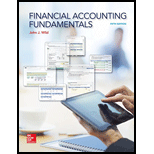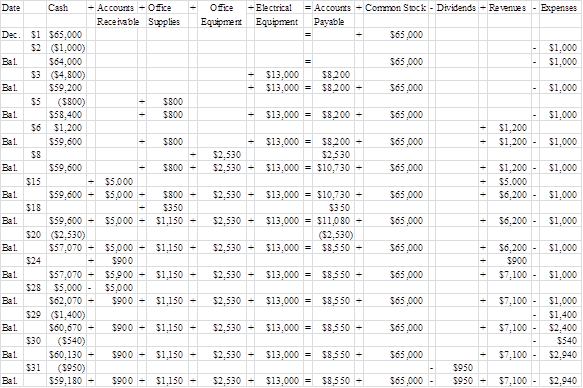
1.
Arrange the asset, liability and equity titles in a table.
1.
Explanation of Solution
The arrangement of asset, liability and equity titles is as follows:

Figure (1)
2.
Create the table showing the effects of each transaction using
2.
Explanation of Solution
The effects of each transaction on the accounts of accounting equation are given bellow:

Figure (2)
3.
Prepare the income statement, statement of
3.
Explanation of Solution
Income statement: Income statement is the financial statement of a company which shows all the revenues earned and expenses incurred by the company over a period of time.
Statement of retained earnings: Statement of retained earnings is an equity statement which shows the changes in the
Balance sheet: This financial statement reports a company’s resources (assets) and claims of creditors (liabilities) and stockholders (stockholders’ equity) over those resources. The resources of the company are assets which include money contributed by stockholders and creditors. Hence, the main elements of the balance sheet are assets, liabilities, and stockholders’ equity.
Statement of cash flows: This statement reports all the cash transactions which are responsible for inflow and outflow of cash, and result of these transactions is reported as ending balance of cash at the end of reported period. Statement of cash flows includes the changes in cash balance due to operating, investing, and financing activities. Operating activities include
Prepare income statement:
| Company S | ||
| Income Statement | ||
| For Month Ended December 31 | ||
| Particulars | Amount ($) | Amount ($) |
| Revenues | ||
| Electrical fees earned | 7,100 | |
| Expenses | ||
| Rent expense | 1,000 | |
| Salaries expense | 1,400 | |
| Utilities expense | 540 | |
| Total expenses | 2,940 | |
| Net income | 4,160 | |
Table (1)
Prepare statement of retained earnings:
| Company S | |
| Statement of Retained Earnings | |
| For Month Ended December 31 | |
| Particulars | Amount ($) |
| Retained earnings, December 1 | 0 |
| Add: | 4,160 |
| Net income | 4,160 |
| Less: | |
| Dividends | 950 |
| Retained earnings, December 31 | 3,210 |
Table (2)
Prepare balance sheet:
| Company S | |||
| Balance Sheet | |||
| For the year ended December 31,2017 | |||
| Assets | Amount ($) | Liabilities | Amount ($) |
| Cash | 59,180 | Accounts payable | 8,550 |
| Accounts receivable | 900 | Equity | |
| Office supplies | 1,150 | Common stock | 65,000 |
| Office equipment | 2,530 | Retained earnings | 3,210 |
| Electrical equipment | 13,000 | Total equity | 68,210 |
| Total assets | 76,760 | Total liabilities and equity | 76,760 |
Table (3)
Prepare statement of cash flows:
| Company S | ||
| Statement of Cash Flows | ||
| For Month Ended December 31 | ||
| Particulars | Amount ($) | Amount ($) |
| Cash flows from operating activities | ||
| Cash received from customers (1) | 6,200 | |
| Cash paid for rent | (1,000) | |
| Cash paid for supplies | (800) | |
| Cash paid for utilities | (540) | |
| Cash paid to employees | (1,400) | |
| Net cash provided by operating activities | 2,460 | |
| Cash flows from investing activities | ||
| Cash paid for office equipment | (2,530) | |
| Cash paid for electrical equipment | (4,800) | |
| Net cash used by investing activities | (7,330) | |
| Cash flows from financing activities | ||
| Cash investment from shareholder | 65,000 | |
| Cash dividend to shareholder | (950) | |
| Net cash provided by financing activities | 64,050 | |
| Net increase in cash | 59,180 | |
| Cash balance, December 1 | 0 | |
| Cash balance, December 31 | 59,180 | |
Table (4)
Working note:
Calculate the cash received from customers:
4.
Explain the effect of change on total assets, total liabilities and total equity.
4.
Explanation of Solution
If the investment of cash on December 1 is $49,000 instead of $65,000 and if the difference of $16,000 was borrowed from bank by the Company, then following is the effect of this change:
(a) Total assets remain the same.
(b) Total liabilities will be $16,000 greater.
(c) Total equity will be $16,000 lower (due to less investment of owner).
Want to see more full solutions like this?
Chapter 1 Solutions
Financial Accounting Fundamentals:
- Can you solve this financial accounting question with accurate accounting calculations?arrow_forwardEcho Corporation had accounts receivable of $95,000 at January 1, 2023. At December 31, 2023, accounts receivable was $75,000. Sales for 2023 totaled $650,000. Compute Echo Corporation's 2023 cash receipts from customers.arrow_forwardGeneral accounting questionarrow_forward
- I need help with this general accounting question using the proper accounting approach.arrow_forwardI want to correct answer general accounting questionarrow_forwardUsing FIFO, calculate ending inventory if purchases were 100 units @ $10, then 100 units @ $12, and 150 units were sold.What is the value of ending inventory?arrow_forward

 AccountingAccountingISBN:9781337272094Author:WARREN, Carl S., Reeve, James M., Duchac, Jonathan E.Publisher:Cengage Learning,
AccountingAccountingISBN:9781337272094Author:WARREN, Carl S., Reeve, James M., Duchac, Jonathan E.Publisher:Cengage Learning, Accounting Information SystemsAccountingISBN:9781337619202Author:Hall, James A.Publisher:Cengage Learning,
Accounting Information SystemsAccountingISBN:9781337619202Author:Hall, James A.Publisher:Cengage Learning, Horngren's Cost Accounting: A Managerial Emphasis...AccountingISBN:9780134475585Author:Srikant M. Datar, Madhav V. RajanPublisher:PEARSON
Horngren's Cost Accounting: A Managerial Emphasis...AccountingISBN:9780134475585Author:Srikant M. Datar, Madhav V. RajanPublisher:PEARSON Intermediate AccountingAccountingISBN:9781259722660Author:J. David Spiceland, Mark W. Nelson, Wayne M ThomasPublisher:McGraw-Hill Education
Intermediate AccountingAccountingISBN:9781259722660Author:J. David Spiceland, Mark W. Nelson, Wayne M ThomasPublisher:McGraw-Hill Education Financial and Managerial AccountingAccountingISBN:9781259726705Author:John J Wild, Ken W. Shaw, Barbara Chiappetta Fundamental Accounting PrinciplesPublisher:McGraw-Hill Education
Financial and Managerial AccountingAccountingISBN:9781259726705Author:John J Wild, Ken W. Shaw, Barbara Chiappetta Fundamental Accounting PrinciplesPublisher:McGraw-Hill Education





